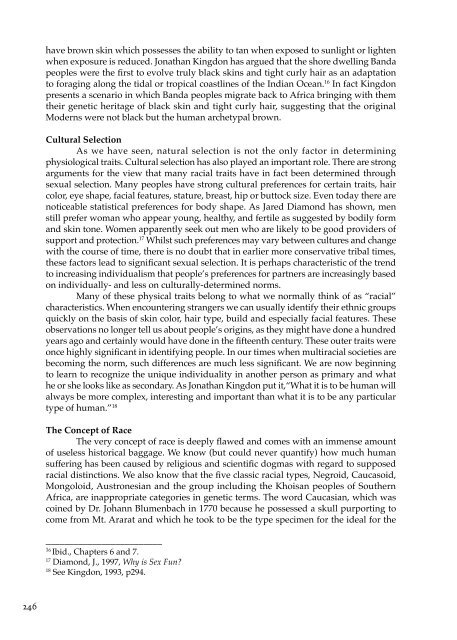The Spirit in Human Evolution - Waldorf Research Institute
The Spirit in Human Evolution - Waldorf Research Institute
The Spirit in Human Evolution - Waldorf Research Institute
You also want an ePaper? Increase the reach of your titles
YUMPU automatically turns print PDFs into web optimized ePapers that Google loves.
have brown sk<strong>in</strong> which possesses the ability to tan when exposed to sunlight or lighten<br />
when exposure is reduced. Jonathan K<strong>in</strong>gdon has argued that the shore dwell<strong>in</strong>g Banda<br />
peoples were the first to evolve truly black sk<strong>in</strong>s and tight curly hair as an adaptation<br />
to forag<strong>in</strong>g along the tidal or tropical coastl<strong>in</strong>es of the Indian Ocean. 16 In fact K<strong>in</strong>gdon<br />
presents a scenario <strong>in</strong> which Banda peoples migrate back to Africa br<strong>in</strong>g<strong>in</strong>g with them<br />
their genetic heritage of black sk<strong>in</strong> and tight curly hair, suggest<strong>in</strong>g that the orig<strong>in</strong>al<br />
Moderns were not black but the human archetypal brown.<br />
Cultural Selection<br />
As we have seen, natural selection is not the only factor <strong>in</strong> determ<strong>in</strong><strong>in</strong>g<br />
physiological traits. Cultural selection has also played an important role. <strong>The</strong>re are strong<br />
arguments for the view that many racial traits have <strong>in</strong> fact been determ<strong>in</strong>ed through<br />
sexual selection. Many peoples have strong cultural preferences for certa<strong>in</strong> traits, hair<br />
color, eye shape, facial features, stature, breast, hip or buttock size. Even today there are<br />
noticeable statistical preferences for body shape. As Jared Diamond has shown, men<br />
still prefer woman who appear young, healthy, and fertile as suggested by bodily form<br />
and sk<strong>in</strong> tone. Women apparently seek out men who are likely to be good providers of<br />
support and protection. 17 Whilst such preferences may vary between cultures and change<br />
with the course of time, there is no doubt that <strong>in</strong> earlier more conservative tribal times,<br />
these factors lead to significant sexual selection. It is perhaps characteristic of the trend<br />
to <strong>in</strong>creas<strong>in</strong>g <strong>in</strong>dividualism that people’s preferences for partners are <strong>in</strong>creas<strong>in</strong>gly based<br />
on <strong>in</strong>dividually- and less on culturally-determ<strong>in</strong>ed norms.<br />
Many of these physical traits belong to what we normally th<strong>in</strong>k of as “racial”<br />
characteristics. When encounter<strong>in</strong>g strangers we can usually identify their ethnic groups<br />
quickly on the basis of sk<strong>in</strong> color, hair type, build and especially facial features. <strong>The</strong>se<br />
observations no longer tell us about people’s orig<strong>in</strong>s, as they might have done a hundred<br />
years ago and certa<strong>in</strong>ly would have done <strong>in</strong> the fifteenth century. <strong>The</strong>se outer traits were<br />
once highly significant <strong>in</strong> identify<strong>in</strong>g people. In our times when multiracial societies are<br />
becom<strong>in</strong>g the norm, such differences are much less significant. We are now beg<strong>in</strong>n<strong>in</strong>g<br />
to learn to recognize the unique <strong>in</strong>dividuality <strong>in</strong> another person as primary and what<br />
he or she looks like as secondary. As Jonathan K<strong>in</strong>gdon put it,“What it is to be human will<br />
always be more complex, <strong>in</strong>terest<strong>in</strong>g and important than what it is to be any particular<br />
type of human.” 18<br />
<strong>The</strong> Concept of Race<br />
<strong>The</strong> very concept of race is deeply flawed and comes with an immense amount<br />
of useless historical baggage. We know (but could never quantify) how much human<br />
suffer<strong>in</strong>g has been caused by religious and scientific dogmas with regard to supposed<br />
racial dist<strong>in</strong>ctions. We also know that the five classic racial types, Negroid, Caucasoid,<br />
Mongoloid, Austronesian and the group <strong>in</strong>clud<strong>in</strong>g the Khoisan peoples of Southern<br />
Africa, are <strong>in</strong>appropriate categories <strong>in</strong> genetic terms. <strong>The</strong> word Caucasian, which was<br />
co<strong>in</strong>ed by Dr. Johann Blumenbach <strong>in</strong> 1770 because he possessed a skull purport<strong>in</strong>g to<br />
come from Mt. Ararat and which he took to be the type specimen for the ideal for the<br />
_________________________<br />
16<br />
Ibid., Chapters 6 and 7.<br />
17<br />
Diamond, J., 1997, Why is Sex Fun?<br />
18<br />
See K<strong>in</strong>gdon, 1993, p294.<br />
246
















